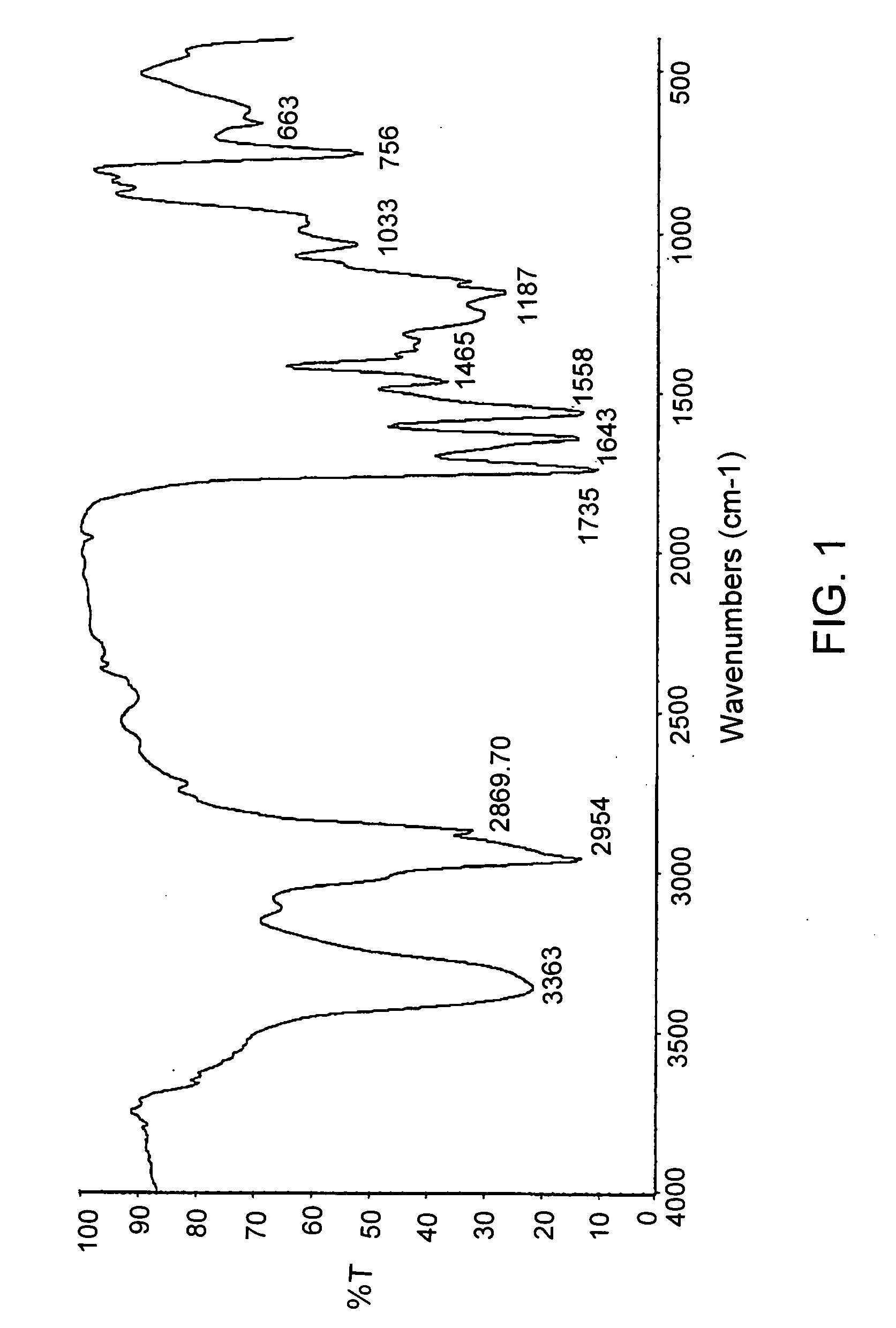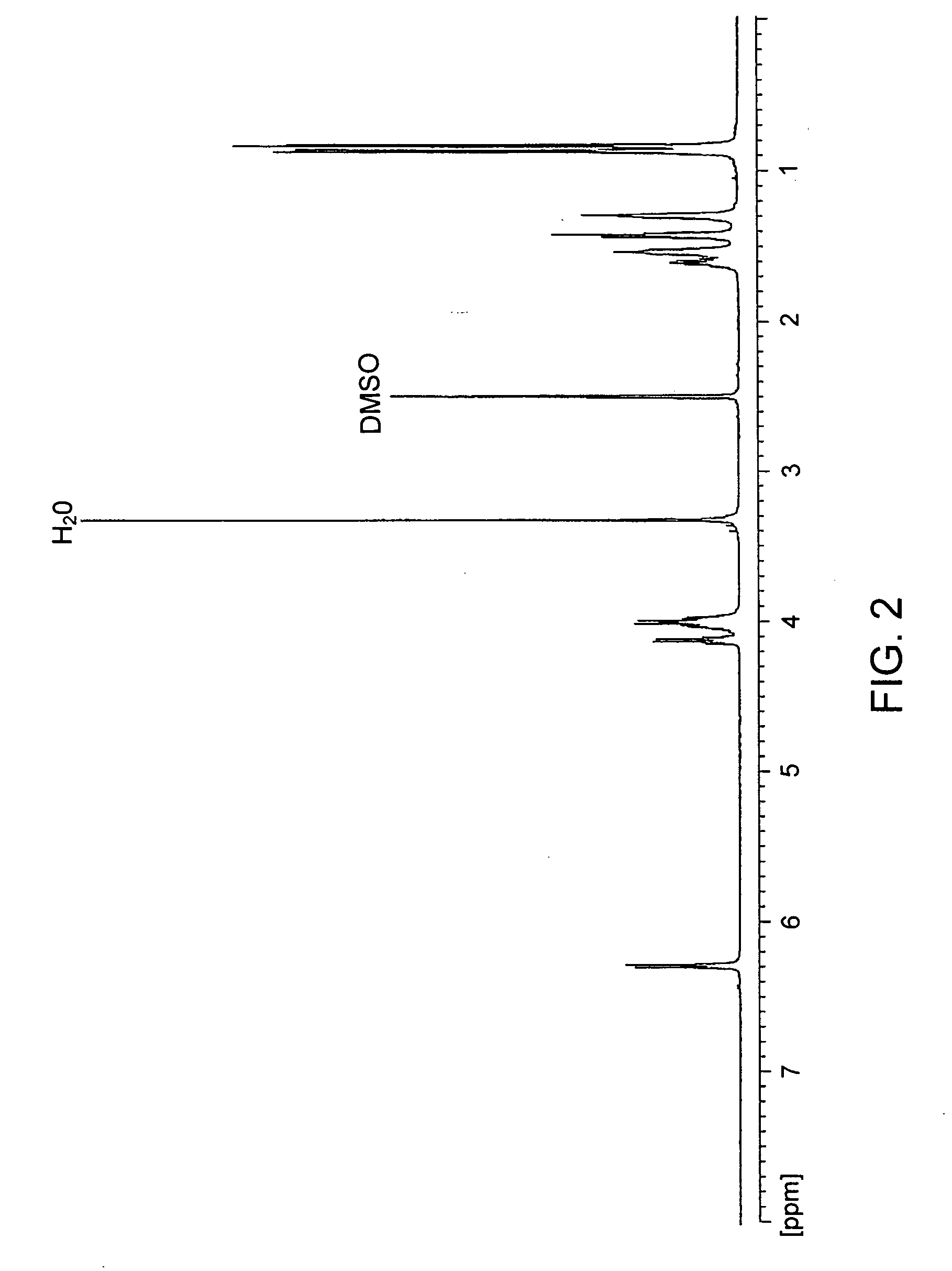Poly(ester urea) polymers and methods of use
a polymer and urea technology, applied in the field of polymer compositions, can solve the problems of chain scission, hydantoin formation, and no information on the synthesis of starting materials, and achieve the effects of high molecular weight, convenient production, and advantageous mechanical, chemical and biodegradation properties
- Summary
- Abstract
- Description
- Claims
- Application Information
AI Technical Summary
Benefits of technology
Problems solved by technology
Method used
Image
Examples
example 1
Monomer Synthesis
[0115] Preparation of Di-p-toluenesulfonic acid salt of bis-L-leucine-hexane-1,6-diester Synthesis of tosylate salts of diamines as nucleophilic monomers has been described previously, for example in U.S. Pat. No. 6,503,538 B1. Di-p-toluenesulfonic acid salt of bis-L-leucine-hexane-1,6-diester (compound 1) was prepared by a modification of the previously published method.
L-leucine (0.132 mol), p-toluenesulfonic acid monohydrate (0.132 mol) and 1,6-hexane diol (0.06 mol) in 250 mL of toluene were placed in a flask equipped with a Dean-Stark apparatus and overhead stirrer. The heterogeneous reaction mixture was heated to reflux for about. 12 h until 4.3 mL (0.24 mol) of water evolved. The reaction mixture was then cooled to room temperature, filtered, washed with acetone and recrystallized twice from methanol / toluene 2:1 mix. Yields and Mp were identical to published data (R. Katsarava et al. J. Polym. Sci., Part A: Polym. Chem. (1999) 37:391-407).
[0116] Prepara...
example 2
Preparation of PEU 1-L-Leu-6 (Polymer entry # 2, Table 1)
[0117] To a suspension of 6.89 g (10 mmol) of di-p-toluenesulfonic acid salt of bis(L-leucine)-1,6-hexanediol-diester in 150 mL of water, 4,24 g (40 mmol) of anhydrous sodium carbonate was added, stirred at room temperature for 30 min. and cooled to 2° C. to 0° C. In parallel, a solution of 0,9893 g (10 mmol) of phosgene in 35 mL of chloroform was cooled to 15° C. to 10° C. The first solution was placed into a reactor for interfacial polycondensation and the second solution was quickly added in bolus and stirred briskly for 15 min. Then the chloroform layer was separated, dried, over anhydrous Na2SO4, and filtered. The obtained solution was evaporated and the polymer yield was dried in vacuum at 45° C. Yield was 82%. For 1H and 13C NMR see FIG. 2 and FIG. 3. Elemental analysis: for C19H34N2O5, calculated values: C: 61.60%, H: 9.25%, N: 7.56%; Found values: C: 61.63%, H: 8.90%, N: 7.60.
example 3
[0118] Preparation of PEU 1-L-Leu-DAS (polymer: entry # 5, Table 1)
[0119] A cooled solution (ice-bath) of 5 g (6.975 mmole) of bis (L-leucine)-1,4:3,6-dianhydrosorbitol-diester and 2.4 g of sodium carbonate in 40 mL of water was prepared. To the cooled solution, 70 mL of chloroform was added with vigorous stirring and then 3.7 mL of 20% phosgene solution in toluene (Fluka) was introduced. Poly(ester urea) formed rapidly with evolution of heat. After the reaction had been stirred for 10 min, the organic layer was rotoevaporated and residual polymer was filtered, washed several times with water, and dried in vacuum over night. Yield of product was 1.6 g. (57%). Polymer properties are as summarized in Table 1.
PUM
| Property | Measurement | Unit |
|---|---|---|
| Time | aaaaa | aaaaa |
| Time | aaaaa | aaaaa |
| Time | aaaaa | aaaaa |
Abstract
Description
Claims
Application Information
 Login to View More
Login to View More - R&D
- Intellectual Property
- Life Sciences
- Materials
- Tech Scout
- Unparalleled Data Quality
- Higher Quality Content
- 60% Fewer Hallucinations
Browse by: Latest US Patents, China's latest patents, Technical Efficacy Thesaurus, Application Domain, Technology Topic, Popular Technical Reports.
© 2025 PatSnap. All rights reserved.Legal|Privacy policy|Modern Slavery Act Transparency Statement|Sitemap|About US| Contact US: help@patsnap.com



